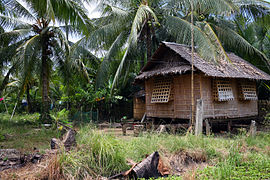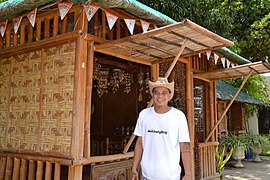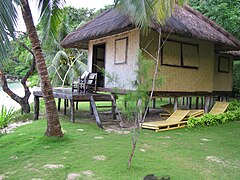
A basket is a container that is traditionally constructed from stiff fibers and can be made from a range of materials, including wood splints, runners, and cane. While most baskets are made from plant materials, other materials such as horsehair, baleen, or metal wire can be used. Baskets are generally woven by hand. Some baskets are fitted with a lid, while others are left open on top.
The culture of the Philippines is characterized by cultural diversity. Although the multiple ethnic groups of the Philippine archipelago have only recently established a shared Filipino national identity, their cultures were all shaped by the geography and history of the region, and by centuries of interaction with neighboring cultures, and colonial powers. In more recent times, Filipino culture has also been influenced through its participation in the global community. "
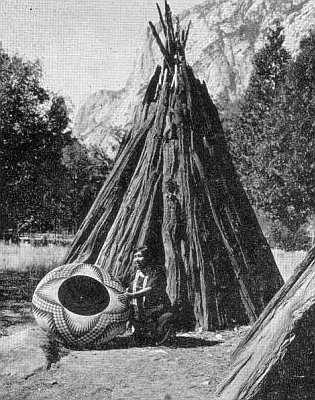
Basket weaving is the process of weaving or sewing pliable materials into three-dimensional artifacts, such as baskets, mats, mesh bags or even furniture. Craftspeople and artists specialized in making baskets may be known as basket makers and basket weavers. Basket weaving is also a rural craft.

The bahay kubo, also known as payag (Nipon) in the Visayan languages and, is a type of stilt house indigenous to the Philippines. It often serves as an icon of Philippine culture. The house is exclusive to the lowland population of unified Spanish conquered territories. Its design heavily influenced the colonial-era bahay na bato architecture.

The Tagbanwa people are one of the oldest ethnic groups in the Philippines, and can be mainly found in the central and northern Palawan. Research has shown that the Tagbanwa are possible descendants of the Tabon Man, thus making them one of the original inhabitants of the Philippines. They are a brown-skinned, slim, and straight-haired ethnic group.

A palapa is an open-sided dwelling with a thatched roof made of dried palm leaves. It is very useful in hot weather and, therefore, very common on Mexican beaches and deserts.

The architecture of the Philippines reflects the historical and cultural traditions in the country. Most prominent historic structures in the archipelago are influenced by Austronesian, Chinese, Spanish, and American architectures.
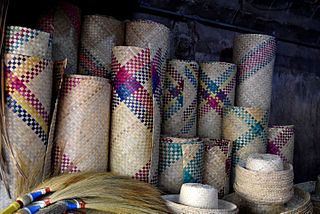
A baníg is a traditional handwoven mat of the Philippines predominantly used as a sleeping mat or a floor mat. Depending on the region of the Philippines, the mat is made of buri (palm), pandanus or reed leaves. The leaves are dried, usually dyed, then cut into strips and woven into mats, which may be plain or intricate.

The Arts in the Philippines are all the arts in the Philippines, from the beginning of civilization to the present. They reflect a range of artistic influences on the country's culture, including indigenous art. Philippine art consists of two branches: traditional and non-traditional art. Each branch is divided into categories and subcategories.
The Culture of Basilan are derived from the three main cultural ethnolinguistic nations, the Yakan, Suluanon Tausug and the Zamboangueño in the southern Philippines. Both Yakans and Tausugs are predominantly Muslim, joined by their kin from the Sama, Badjao, Maranao, and other Muslim ethnolinguistic groups of Mindanao, while the Zamboangueños are primarily Christian, joined by the predominantly Christian ethnolinguistic groups; the Cebuano, Ilocano, Tagalog and others. These three main groups, however, represent Basilan's tri-people or tri-ethnic group community.
Reed mats are handmade mats of plaited reed or other plant material.
A woven mat is a type of mat that is created by weaving and may include:

A pakudos is a visual motif used by the Hanunuo Mangyan people of Mindoro in the Philippines. Pakudos are characterized by symmetrical, aesthetic, and orderly utilization of lines and space with equal utilization of vertical and horizontal composition. The word pakudos was coined from cruz, the Spanish word for cross. The pakudos motif is a common element in Mangyan embroidery and crafts. It is also featured on the official seal of San Jose, Occidental Mindoro.
Bahalina, sometimes called "coconut red wine", is a traditional Filipino palm wine made from fermented coconut or nipa palm sap. It is derived from tubâ that has been aged for several months to several years. It originates from the Visayas and Mindanao islands of the southern Philippines. It is deep brown-orange in color and has a slightly bitter astringent taste.

The field of Indigenous architecture refers to the study and practice of architecture of, for and by Indigenous people. It is a field of study and practice in the United States, Australia, Aotearoa/New Zealand, Canada, Arctic area of Sápmi and many other countries where Indigenous people have a built tradition or aspire translate or to have their cultures translated in the built environment. This has been extended to landscape architecture, urban design, planning, public art, placemaking and other ways of contributing to the design of built environments.
Indigenous materials are materials that are naturally and locally found in a specific place such as timbers, canes,grass, palms, and rattan. Other indigenous raw materials in the country that are commonly known and used creatively in crafts and decoration are capiz, pearls, corals, and seashells, being an archipelago naturally abundant in beaches and marine resources.

Pusô or tamu, sometimes known in Philippine English as "hanging rice", is a Filipino rice cake made by boiling rice in a woven pouch of palm leaves. It is most commonly found in octahedral, diamond, or rectangular shapes, but it can also come in various other intricately woven complex forms. It is known under many different names throughout the Philippines with numerous variations, but it is usually associated with the street food cultures of the Visayan and Moro peoples.
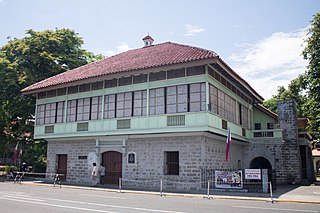
Bahay na bato is a type of building originating during the Philippines' Spanish colonial period. It is an updated version of the traditional bahay kubo of the Christianized lowlanders, known for its use of masonry in its construction, using stone and brick materials and later synthetic concrete, rather than just full organic materials of the former style. Its design has evolved throughout the ages, but still maintains the bahay kubo's architectural principle, which is adapted to the tropical climate, stormy season, and earthquake-prone environment of the whole archipelago of the Philippines, and fuses it with the influence of Spanish colonizers and Chinese traders. It is one of the many architecture throughout the Spanish Empire known as Arquitectura mestiza. The style is a hybrid of Austronesian, Spanish, and Chinese; and later, with early 20th-century American architecture, supporting the fact that the Philippines is a result of these cultures mixing together. Its most common appearance features an elevated, overhanging wooden upper story standing on wooden posts in a rectangular arrangement as a foundation. The posts are placed behind Spanish-style solid stone blocks or bricks giving the impression of a first floor, but the ground level is actually storage rooms, cellars, shops, or other business-related functions. The second floor is the elevated residential apartment, as it is with the bahay kubo. The roof materials either tiled or thatched, with later 19th-century designs featuring galvanization. Roof styles, traditionally high pitched with, or gable roof, Hip roof, East Asian Hip roof, simplier East Asian hip-and-gable roof, Horses for carriages were housed in stables called caballerizas.
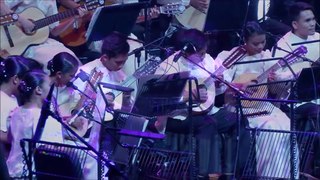
"Bahay kubo" is a Tagalog-language folk song from the lowlands of Luzon, Philippines. In 1924, it was included in a collection of Filipino folk songs compiled by Emilia S. Cavan.

Camiña Balay Nga Bato, formerly known as Avanceña House, is a century-old heritage house in the Arevalo district, Iloilo City, Philippines. It was built in 1865 and was designed by the first parish priest of Molo, Anselmo Avanceña, for Don Fernando Avanceña and his wife, Eulalia Abaja. It was then passed on from one family to another until it came under the Camiñas family.[1] It is now owned by the fourth generation of the original owners, Gerard Camiña, former director of the Land Transportation Office in Western Visayas, and his wife, Luth Camiña. The ancestral house was declared as an "important cultural property" by the National Museum in 2015.

